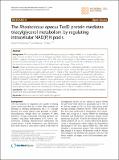The Rhodococcus opacus TadD protein mediates triacylglycerol metabolism by regulating intracellular NAD(P)H pools
Author(s)
MacEachran, Daniel P.; Sinskey, Anthony J
Download1475-2859-12-104.pdf (645.2Kb)
PUBLISHER_CC
Publisher with Creative Commons License
Creative Commons Attribution
Terms of use
Metadata
Show full item recordAbstract
Background:
The Gram-positive actinomycete Rhodococcus opacus is widely studied for its innate ability to store large amounts of carbon in the form of triacylglycerol (TAG). Several groups have demonstrated that R. opacus PD630 is capable of storing anywhere from 50 to 76% of its cell dry weight as TAG. While numerous studies have focused on phenomenological aspects of this process, few have sought to identify the underlying molecular and biochemical mechanisms responsible for the biosynthesis and storage of this molecule.
Results:
Herein we further our previous efforts to illuminate the black box that is lipid metabolism in actinomycetes using a genetic approach. Utilizing a simple, colorimetric genetic screen, we have identified a gene, referred to herein as tadD (triacylglycerol accumulation deficient), which is critical for TAG biosynthesis in R. opacus PD630. Furthermore, we demonstrate that the purified protein product of this gene is capable of oxidizing glyceraldehyde-3-phosphate, while simultaneously reducing NAD(P)[superscript +] to NAD(P)H. Supporting this biochemical data, we observed that the ratio of NAD(P)H to NAD(P)[superscript +] is elevated in wildtype cultures grown under lipid production conditions as compared to cultures grown under vegetative growth conditions, while the mutant strain demonstrated no change irrespective of growth conditions. Finally, we demonstrate that over-expressing a putative phosphorylative glyceraldehyde-3-phosphate dehydrogenase leads to decreased TAG production during growth on TAG accumulation conditions.
Conclusion:
Taken together, the data support the identification of a key metabolic branch point separating vegetative growth and lipid accumulation lifestyles in Rhodococcus.
Date issued
2013-11Department
Whitaker College of Health Sciences and Technology; Massachusetts Institute of Technology. Department of Biology; Massachusetts Institute of Technology. Engineering Systems DivisionJournal
Microbial Cell Factories
Publisher
BioMed Central Ltd
Citation
MacEachran, Daniel P, and Anthony J Sinskey. “The Rhodococcus Opacus TadD Protein Mediates Triacylglycerol Metabolism by Regulating Intracellular NAD(P)H Pools.” Microbial Cell Factories 12.1 (2013): 104.
Version: Final published version
ISSN
1475-2859